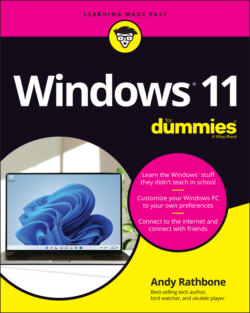Читать книгу Windows 11 For Dummies - Andy Rathbone - Страница 42
Working with the Desktop
ОглавлениеThe desktop lets you run several apps and programs simultaneously, each living within its own little window. That separation lets you spread several programs across the screen, sharing bits of information among them.
When first installed, Windows starts with the freshly scrubbed, nearly empty desktop shown earlier in Figure 3-1. After you’ve been working for a while, your desktop will fill up with icons — little buttons that load your files with a quick double-click. Many people leave their desktops strewn with icons for easy access.
Other people organize their work: When they finish working on something, they store their files in folders, which are places for storing similar items, that I cover in Chapter 4.
No matter how you use the desktop, it comes with three main parts, labeled earlier in Figure 3-1:
Start button: To launch a program, click the Start button. It’s the first icon on the right of the taskbar, that strip that runs along the bottom of your desktop. When the Start menu appears, click the name or icon for the app or program you want to run.I cover the Start menu and all its quirks in Chapter 2. (Flip back to that chapter if you want to remove or rearrange the Start menu’s app icons.) For easy access to your favorite programs, place them on your desktop’s taskbar (described below).
Taskbar: Resting lazily along the bottom edge of your screen, the taskbar shows icons for the apps and programs you currently have open, as well as icons for launching a few favored programs. (Hover your mouse pointer over a program’s icon on the taskbar to see the program’s name or perhaps a thumbnail photo of that program in action.) I describe how to add your favorite programs’ icons to the taskbar later in this chapter’s “Customizing the taskbar” section.
Recycle Bin: The desktop’s Recycle Bin, that wastebasket-shaped icon, stores your recently deleted files and folders for easy retrieval. Whew!
I cover these items later in this chapter and throughout the book, but the following tips will help you until you page ahead:
PC and laptop owners can start new projects directly from the Windows desktop: Right-click a blank part of the desktop, choose New Item, and choose the project of your dreams from the pop-up menu, be it loading a favorite program or creating a folder to store new files. (The New Item menu even lists some of your computer’s programs, sparing you a journey back to the Start menu.)
Are you befuddled about a desktop object’s reason for being? Timidly rest the pointer over the mysterious doodad, and Windows often pops up a little box explaining what that thing is or does. Right-click the object, and the ever-helpful Windows usually tosses up a menu listing nearly everything you can do with that particular object. This trick works on most icons and buttons found on your desktop and its programs.
All the icons on your desktop may suddenly disappear. To bring your work back to life, right-click your empty desktop and choose View from the pop-up menu. Then make sure the Show Desktop Icons menu option has a check mark so that everything stays visible.
